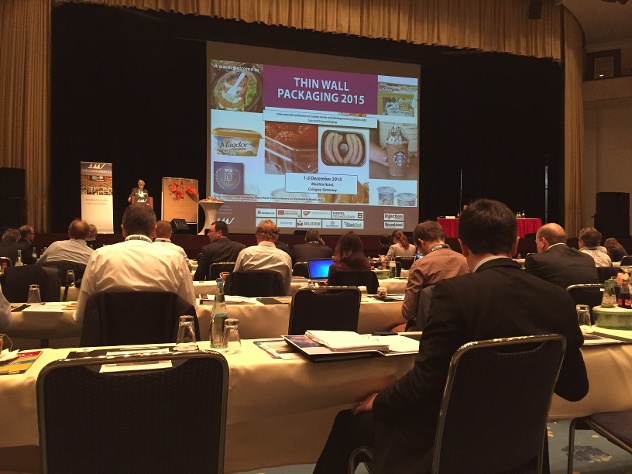CMT Field Notes: 2015 European Thin Wall Packaging Conference
This year marked the 10th anniversary of AMI’s Thin Wall Packaging Conference in Europe. What started as a small gathering with only 48 people in 2005 is now an important industry event that consistently draws over 200 delegates. Brand owners, resin suppliers, converters and OEMs from both sides of the Atlantic are drawn to the city of Cologne to hear the latest developments in materials and processes for thermoformed and injection molded thin wall packaging. With conferences already established in Europe and North America, AMI is expanding to Southeast Asia next year with a new event in Singapore (September 20-21).
Martyna Fong, Packaging Consultant, of AMI opened the proceedings with a summary of industry trends over the past ten years. It was interesting to note that several themes are still evident today, including T-IML and injection compression molding. This could suggest a long technology adoption curve on the part of converters or simply a lack of compelling project economics against established processes. T-IML in particular has not entirely convinced major converters to switch from dry-offset and other decoration methods despite multi-year and multi-million dollar investments by OEMs.

With ~2.9bn tons of resin and a projected CAGR of 1.1% from 2015-2020 in the EU-28 region, the TWP sector is mature, though innovations and investments continue throughout the value chain. AMI identified 4 major themes / megatrends over the decade: sustainability (light-weighting, waste and energy recovery); financial pressures (rising costs, consolidation); barrier packaging (extended shelf life, new technologies) and shelf appeal (decorative designs, customer convenience). Key innovations include technology and materials related to ready-meals and baby food while the democratization of luxury continues to drive new and sexy packaging for espresso, gelato and chocolate.
By way of comparison, AMI’s data (2013) for the North American market shows ~3.5 billion tons of resin in TWP with 56% used in food service applications. The Chicago-based conference is held every May and is proving to be an attraction for many of the same global players who operate in multiple markets.
AMI is a central meeting point for many players in the thermoforming industry. With a large European contingent of OEMs and toolmakers such as Gabler, Kiefel, Illig, WM and Marbach, we at CMT are able to learn about new projects and get a sense for how the industry the doing. Several large US thermoformers were also in attendance. During discussions, people indicated that the lead times for new tools were expanding which would suggest a healthy level of growth.
If one product in particular could be said to epitomize thin wall packaging, it would have to be the K-cup-style coffee capsule. Thermoformed or injection molded, the exponential growth of this convenient little package has provided stimulus for the entire supply chain from resin suppliers to a well-caffeinated public. That said, the environmental end-of-life questions remain thorny and unresolved though the move to a PP/EVOH/PP sheet structure should make recycling more viable.
Consumer preferences appear to be the single biggest driving factor behind innovations in thin wall packaging. Regulation will play an increasing role in some areas. France, for example, has a proposed ban on plastic disposables coming in to effect in 2020. Interested parties continue to observe the back and forth over bag bans in various US states to see what the broader implications will be for all plastics packaging.

